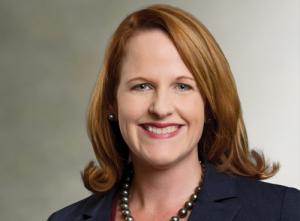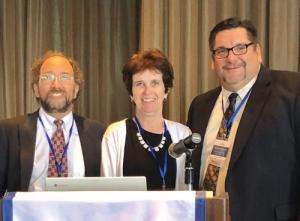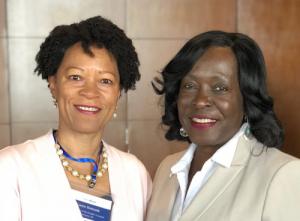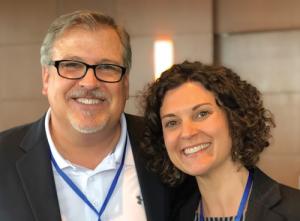NASUCA Mid-Year Meeting
Sheri Givens is President of Givens Consulting LLC (dba Givens Energy), providing energy consulting services to a wide range of clients on regulatory and consumer education issues. She is also a former state utility consumer advocate and member of the NASUCA Executive Committee.
Home to Target's headquarters and the birthplace of Prince, Minneapolis provided a warm Midwest welcome for utility consumer advocates from across the nation from June 24-27, 2018 for the Mid-Year Meeting of the National Association of State Utility Consumer Advocates.

Nearly a hundred and forty people convened on the fiftieth floor of the North Star state's tallest building, IDS Tower, to network, debate, learn, and take in the breathtaking views of the city's stunning skyscrapers and river, colossal professional sports stadiums, and countless green parks and grass-lined rooftops.
NASUCA is the non-profit organization providing ratepayer advocates nationwide an opportunity to communicate with one another, enhance member impact on public policy at the state and federal levels, and assist members in the representation of utility consumer interests. NASUCA provides opportunities for its members to interact with industry and government representatives by convening two association meetings annually.
Unlike their utility regulatory agency counterparts that began in the late 1800s, consumer advocate agencies appeared in the 1970s, created by state legislatures after the energy crisis drove up gas and electric prices. Established in 1979, with sixteen founding members, NASUCA has now grown to fifty-five-member offices in forty-three states and the District of Columbia, Barbados, Puerto Rico, and Jamaica.
If you have never attended a NASUCA conference, you are certainly missing out. Though there are some closed meetings for advocates only, most of the meetings welcome all registrants to attend, engage, and participate. You can always visit the NASUCA website to check for upcoming meetings, agendas, registered attendees, and presentations given.
 Ratemaking Mechanism Panel: Edward Kaufman, Chief Technical Advisor, Indiana Office of Consumer Counselor; Maureen Westbrook, Vice President, Customer and Regulatory Affairs, Connecticut Water Company; Richard Sobolewski Supervisor of Utility Financial Analysis, Connecticut Office of Consumer Counsel
Ratemaking Mechanism Panel: Edward Kaufman, Chief Technical Advisor, Indiana Office of Consumer Counselor; Maureen Westbrook, Vice President, Customer and Regulatory Affairs, Connecticut Water Company; Richard Sobolewski Supervisor of Utility Financial Analysis, Connecticut Office of Consumer Counsel
Like NARUC, NASUCA holds a summer, or mid-year meeting, annually; however, unlike its annual meeting, which is co-located with NARUC, the mid-year meeting is typically held at a different location from NARUC in June each year.
Over half of this year's participants hailed from advocate agencies from coast-to-coast with a sprinkling of utility executives, federal agency staff, grid operators, trade association representatives, technology providers, consultants, attorneys, and other invited speakers.
At its November 2017 annual meeting, NASUCA elected its latest slate of officers and executive committee. The twenty-first and current NASUCA President, Elin Swanson Katz, Connecticut's Consumer Counsel, is the fifth woman to hold the role of President, beginning her term in November 2017.
The Mid-Year Meeting was her first opportunity to preside over her fellow advocates, doing so with the same upbeat enthusiasm, great sense of humor, and warmth many have experienced since she became an advocate in her state in 2011.
 District of Columbia Public Counsel, and head of office, Sandra Mattavous-Frye and Karen Sistrunk on staff there.
District of Columbia Public Counsel, and head of office, Sandra Mattavous-Frye and Karen Sistrunk on staff there.
Not only did she emcee, Katz actively participated in the conference, moderating and participating on panels, showing her depth and breadth of expertise and asking engaging questions of nearly every speaker at the podium.
Everyone knows that the behind-the-scenes work is done by an organization's Executive Director and team. David Springe, named to the position in 2015, stepped up to the plate and hit a homerun with this conference.
He worked with his committees, members, and panelists to ensure this year's meeting was a standout from years past with a new format, concurrent sessions. Those provided opportunities for attendees to choose different tracks - electric and other - including communications, gas, and technologies. Many in the industry know him from his prior role as the Kansas Consumer Counsel and former NASUCA President.
AARP, a longstanding affiliate member, has stepped up the past two years to become one of NASUCA's biggest conference sponsors. Others, like the American Gas Association, Edison Electric Institute, and American Wind Energy Association, along with consultants, law firms, non-profits and other trade associations, served as sponsors this summer as well.
Day 1: Training, Resolutions and Oklahoma!
 David Springe, Executive Director, NASUCA; Sara Baldwin Auck, Director, Regulatory Program, Interstate Renewable Energy Council.
David Springe, Executive Director, NASUCA; Sara Baldwin Auck, Director, Regulatory Program, Interstate Renewable Energy Council.
This year's meeting hosted special guests from Lawrence Berkeley National Laboratory and GE Energy Consulting who led the participants in over four-and-a half-hours of distribution training. LBNL, in conjunction with the U.S. Department of Energy, provides educational training opportunities for NASUCA members.
NASUCA members previously had access to two webinars, on May 23 and June 5, on distribution planning prior to the mid-year meeting, and the in-person meeting provided additional detailed information to benefit all in understanding the importance of distribution for grid reliability.
LBNL's Lisa Schwartz kicked off the training session by discussing the U.S. Department of Energy's Grid Modernization Initiative, working to create the modern grid of the future, which includes enhancements to distribution planning and making that planning more stakeholder oriented.
Following the training, during the afternoon's closed session, NASUCA members discussed and adopted two new resolutions. Under NASUCA's constitution, resolutions are "any formal expression of an official position by the association." Adoption of a resolution requires a two-thirds vote of the members present at the meeting where it is introduced. NASUCA resolutions have historically been used in state and federal proceedings as the basis for, or to supplement, the voice of consumer advocates.
This summer's resolutions included one relating to consumer protections as electric vehicle adoption rates increase and another related to protecting households with chronically-ill or disabled residents from service disconnection. All NASUCA resolutions are available on its website.
NASUCA also welcomed a new member to the fold, the Oklahoma Attorney General's Public Utility Unit, which represents and protects the interests of the state's utility customers in rate-related proceedings, participates in rulemaking proceedings, and performs other tasks related to public utility regulation.
After an afternoon of robust discussion, a reception followed, providing the advocates and registrants an opportunity to mix, mingle, and reflect, making for the perfect end to the day of learning and engagement.
Following the fellowship, an open evening provided attendees with ample opportunities to scout out the food scene. No visit to the river city would be complete without culinary outings to local-area steakhouses for carts of dry-aged steaks. Another delicious outing is a visit to one of its various burger establishments that serves up Juicy Lucy's, a hamburger filled with molten American cheese with your choice of condiments and accoutrements ranging from house-made peanut butter to sweet and spicy red pepper jelly.
Day 2: A U.S. Senator, Concurrent Sessions & A Shindig
NASUCA's President Elin Katz welcomed everyone to the meeting. Katz also discussed the new concurrent session format NASUCA was trying out in adjacent rooms, giving participants an option to pick and choose the topic most pressing to their office or highest on their list of interest and priorities.
She also pointed out that the first two concurrent sessions featured staff from her Connecticut office. Katz kidded that she felt like a mother having to choose between her two favorite sons. Like every good mom, she offered to spend equal time in each of their rooms.
Former Colorado consumer advocate, and AARP Colorado pro bono attorney, Bill Levis provided introductory remarks for a video message provided by U.S. Senator Amy Klobuchar of Minnesota.
She shared information about all the intensive work she is doing on the Hill to advance the rights of consumers in broadband, cell phones, and other communications areas. Like Katz, the Senator had everyone in stitches when she joked about how she relished being the only Slovenian in D.C. until Melania Trump arrived, and how she now feels like she's "looking in the mirror" when she sees the First Lady.
Under the new session format, members of the NASUCA Executive Committee "ran the rooms," providing morning and afternoon introductions of panels and updates on schedules throughout the day.
They even helped moderators in calling time to ensure no speakers went beyond their limits, helping maintain the orderly flow between the rooms and networking breaks. It ran like clockwork, and everyone was complimentary of the flow.
In one room, two panelists on constructive ratemaking mechanisms provided refreshing perspectives on the power of collaboration between advocates and utilities. The Connecticut Consumer Counsel's Office and Connecticut Water highlighted the importance of continuing the dialogue to find solutions and building a foundation of trust to bring benefits to both the consumer and the company.
The admiration between the two speakers was apparent as the company acknowledged the legislature's and market stakeholder's recognition of the advocate's office as the "voice of the consumer."
The advocate noted there were far fewer rate-case applications with the new ratemaking mechanisms in place. Across the hall, speakers engaged their audience with a discussion on distributed energy resource rate design and net energy metering activities occurring across the United States.
NASUC-ans enjoy engaging with their host state's regulators during their bi-annual meetings; however, the Minnesota Public Utilities Commission was occupied with a major pipeline proceeding.
Even so, advocates were delighted that Vice Chairman Dan Lipschultz was able to fit in a thirty-minute engaging dialogue, led by The Utility Reform Network's own Regina Costa, who also happens to serve as the NASUCA Telecommunications Committee Chair.
Lipschultz regaled the audience with his expertise, insights, and knowledge on all things broadband and communications, including the latest on numerous state, FCC, and other proceedings. Additionally, Chair Nancy Lange stopped by NASUCA's Monday evening reception to socialize with the advocate community.
One of the best panels of the day had to be the women of NASUCA debating the issues. NASUCA has a long history of significant participation by women as Presidents, Heads of Office, attorneys, experts, and staff. Michele Beck (Utah), Kristen Munsch (Illinois), Sandra Mattavous-Frye (D.C.), and President Katz shared personal stories about their experience as women in the energy industry.
They further touched on the importance of reaching out to women heads of households, low-income consumers, and senior citizens on utility issues, without appearing condescending, while giving voice to the voiceless and engaging those lacking the time to be concerned.
Oftentimes, as one speaker stated, advocates can be perceived as "skunks at the garden party," but as demonstrated by this powerful panel, these hardworking leaders evidenced the positive impacts advocates overall have in their communities.
The concurrent sessions offered numerous opportunities for invited speakers to share their expertise on a wide range of topics: municipal broadband, customer charges, dynamic rate design, Lifeline, blockchain technologies, electric vehicles, energy storage, gas reliability, consumer brochures, utility impostor scams, grid modernization investment tools, and offshore wind. Nearly fifty speakers provided their insights to the two rooms during a single day.
After a long and lively first full day of meetings, NASUC-ans walked a couple of blocks down the street for a get-together, at the aptly-named Shindig, to continue the day's discussions.
Day 3: More Training, Smart Cities & C-Suite Speaks
Tuesday kicked off with two additional hours of LBNL distribution training followed by an eye-opening discussion on the energy needs of low-income consumers suffering from serious medical issues.
Charlie Harak, of the National Consumer Law Center, stressed the importance of electric service to those with refrigerated medications, powered wheelchairs, and those elderly and children at-risk for hypothermia. He shared that Massachusetts' three largest companies have approximately seventy-five thousand electric disconnections a year, while California is approaching a million.
"Legislation can mandate protections, regulators can adopt protections, and companies can voluntarily help those in need of protections," said Harak.
In response to rising shutoffs, California's advocate, TURN, shared about its work in increasing its grassroots and health partnerships and advocating before the legislature to help reduce disconnections.
In May, TURN published a report, "Living Without Power," on energy insecurity and the public health threats it poses in the state. The local Minnesota utility, Xcel Energy, also shared its initiatives for medical needs customers in its jurisdictions.
Smart cities are a hot topic of debate across the country, and that debate erupted at the NASUCA meeting. Dan Pfeiffer of Itron offered his perspective and highlighted technologies Itron is working on with utilities and cities.
Dr. Massoud Amin of the University of Minnesota, and IEEE Smart Grid Chair, touched on the twenty-year history of the smart grid, or "smart self-healing grid" as it was known then, and stressed the importance of meeting the customers where they are. He focused on the consumer societal benefits of smart grids and smart cities, opined on the criticality of the grid, and stressed the importance of standards and interoperability.
Next up was a utility executive panel with AEP, PJM, and Xcel Energy. One exec touched on how the regulatory paradigm brought universal service to all, enabling each of us to have decent and reliable service, but he questioned whether those who cannot afford the new emerging technologies options might be at risk of being left behind.
Another stressed the importance of the utility listening to the voices of the consumers and finding solutions about what they want, not what the utility believes they want. The grid operator shared that there is value in having consumer advocates being active in the stakeholder process as it is hard for them to outreach their "customers' customers."
Other speakers during the day focused on the implications of electrification, the Tax Cuts and Jobs Act, implementing grid-edge technologies, and the work left to be done in Puerto Rico since the aftermath of Hurricane Maria.
After the conclusion of the meetings, one utility executive opined on the value of engaging advocates more often and the importance of attending the bi-annual meetings. He plans to encourage fellow utility executives to attend future events.
One advocate, and head of office, raved that this mid-year meeting was the best he had been to in his eleven years of attending NASUCA meetings.
Indeed, it was a very good meeting. And, yes, there is value in advocates, utilities, regulators, technology companies, consultants, and other market participants joining together, discussing their differences, and trying to find common ground.
Be sure to take advantage of your next opportunity to engage the advocate community at its in-person meeting in Orlando, November 11-14, 2018. It will be co-located with NARUC. You will be glad you did. For more information about NASUCA and its meeting, you can visit its website, NASUCA.org and follow NASUCA on twitter @NASUCADC.


